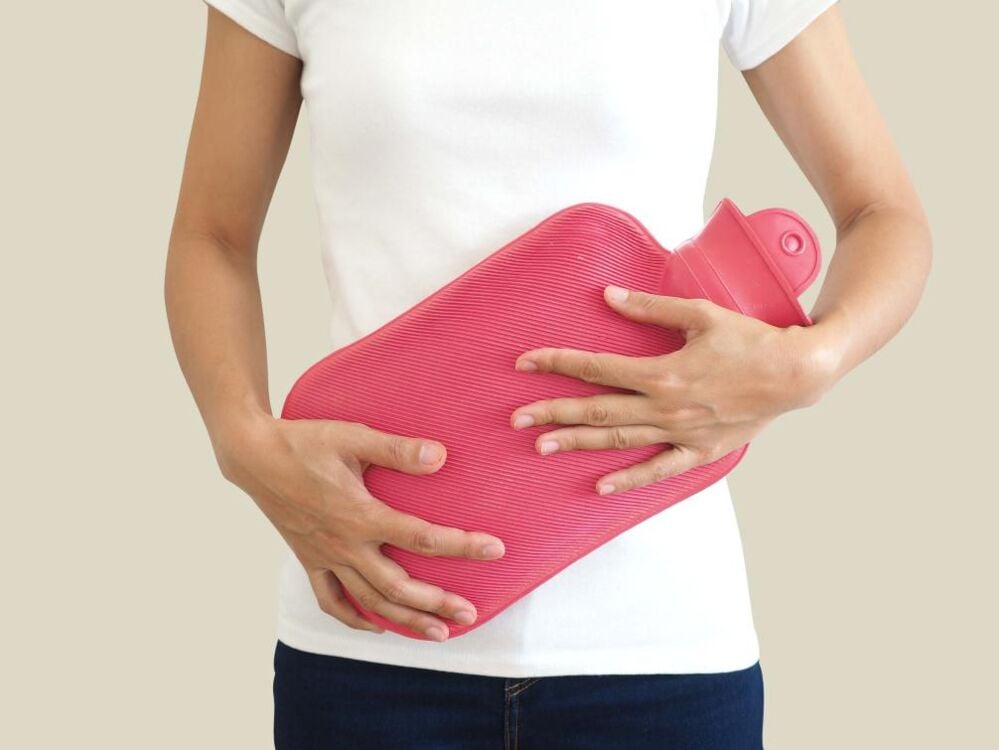-
Tracking cycle
-
Getting pregnant
-
Pregnancy
-
Help Center
-
Flo for Partners
-
Anonymous Mode
-
Flo app reviews
-
Flo Premium New
-
Secret Chats New
-
Symptom Checker New
-
Your cycle
-
Health 360°
-
Getting pregnant
-
Pregnancy
-
Being a mom
-
LGBTQ+
-
Quizzes
-
Ovulation calculator
-
hCG calculator
-
Pregnancy test calculator
-
Menstrual cycle calculator
-
Period calculator
-
Implantation calculator
-
Pregnancy weeks to months calculator
-
Pregnancy due date calculator
-
IVF and FET due date calculator
-
Due date calculator by ultrasound
-
Medical Affairs
-
Science & Research
-
Pass It On Project New
-
Privacy Portal
-
Press Center
-
Flo Accuracy
-
Careers
-
Contact Us
What Is Dysmenorrhea? Everything You Need To Know About Painful Periods


Every piece of content at Flo Health adheres to the highest editorial standards for language, style, and medical accuracy. To learn what we do to deliver the best health and lifestyle insights to you, check out our content review principles.

Painful periods are pretty common, and most of us have spent many an afternoon on the sofa, eating ice-cream by the bucketload while waiting for pain relief to kick in and cramps to subside.
For many of us, period pain is an annoyance that, thankfully, doesn’t interfere too much with our everyday lives. However, studies have shown that 20 percent of us experience period pain that’s so severe and disruptive that we have to cancel plans or change the way we dress. The medical name for very painful periods is dysmenorrhea, which we’ll discuss in detail below.
Take a quiz
Find out what you can do with our Health Assistant
What is dysmenorrhea?
Stomach cramps, along with acne and bloating, are a natural part of the menstrual cycle, with nearly 75 percent of women and people who menstruate reporting some form of abdominal cramps either before, or during, their period. While some people feel the pain in their lower back, period pain typically targets the lower abdomen.
So what exactly is dysmenorrhea? It’s officially defined as particularly intense or sustained period cramps in the stomach and lower abdomen, which can sometimes cause other symptoms like:
- Pain in your lower back or radiating pain down your legs
- Nausea or vomiting
- Diarrhea

What’s the difference between primary and secondary dysmenorrhea?
Dysmenorrhea falls into two categories, and if you have it you’ll either be diagnosed with primary dysmenorrhea or secondary dysmenorrhea, depending on your symptoms.
Primary dysmenorrhea refers to any cramping that is triggered specifically by menstruation and your period.
Secondary dysmenorrhea is slightly different. This is cramping that is associated with reproductive health conditions, like endometriosis, fibroids, polyps, or pelvic inflammatory disease (PID).
What Causes Dysmenorrhea?
Primary dysmenorrhea is the pain caused by your body preparing itself for your period. When you have a period, you produce chemicals called prostaglandins that affect your perception of pain. They also regulate inflammation, blood pressure, and clotting. And when your uterus contracts to shed its lining, these contractions can cause cramps, or dysmenorrhea in more severe cases.
Secondary dysmenorrhea is related to reproductive health conditions like:
- Endometriosis
Endometriosis is a condition where tissue similar to the lining of the uterus starts to grow in other places, such as the ovaries and uterine tubes. - Fibroids
Fibroids are non-cancerous growths that can develop in the uterus. They are made up of muscle and fibrous tissue and vary in size. - Infection of the reproductive organs
Conditions like PID, which is an infection of the upper uterus, ovaries, and uterine tubes, can cause secondary dysmenorrhea. - Cervical stenosis
Cervical stenosis happens when the opening of a cervix is too small to allow your uterine lining to freely come out during your period, causing pain or pressure. - Adenomyosis
Adenomyosis occurs when the uterine lining grows into the smooth muscle layer of the uterus.
How to treat dysmenorrhea
Whether you’re experiencing primary or secondary dysmenorrhea, you’ll no doubt be looking for ways to soothe the pain.
Over-the-counter pain medication like acetaminophen (paracetamol) and ibuprofen are often enough to help alleviate the pain, as long as you take the correct dose.
In addition to ibuprofen, other nonsteroidal anti-inflammatory drugs (NSAIDs) can also reduce the amount of prostaglandins your body produces, which could help dial down the intensity of your period cramps.
Studies have also shown that another useful weapon for fighting the pain of dysmenorrhea is hormonal birth control, like the pill, patch, or vaginal ring. The most effective options typically include both the sex hormones estrogen and progestin (a synthetic form of the hormone progesterone).
If none of these seem to help with the pain, don’t feel too disheartened. There are other treatment options available that your healthcare professional can advise you on to determine what’s right for you and make the best plan possible.
What else can help with dysmenorrhea?
If you’re living with dysmenorrhea, there are a few lifestyle changes you can try alongside taking medicine. Practicing self-care like massage, meditation, and acupuncture or gentle exercising, such as yoga, around your period can help you feel more relaxed.
Heat is your new best friend as it’s proven to be really effective at relieving cramps. Curl up in front of your favorite TV show with a hot water bottle or heat patch or take a warm bath or shower. You could even add a few drops of lavender oil to your bath to up the relaxation factor.
Alternatively, whip yourself up a comforting cup of ginger tea. Studies have shown that fresh root ginger may contribute to easing period pains.

Dysmenorrhea: The takeaway
Living with period pain can be … well, a pain, and it’s normal to feel frustrated by it. So, if you’re struggling on a monthly basis, or the pain is more intense than previous periods, we’d suggest putting your mind at ease and having a chat with your doctor. While you wait for an appointment, you can try some of the alternatives we suggested, but don’t feel disheartened if not much seems to help. Your healthcare professional will be able to give you a proper checkup and recommend a plan of action to help you manage painful cramps.


Hey, I'm Anique
I started using Flo app to track my period and ovulation because we wanted to have a baby.


The Flo app helped me learn about my body and spot ovulation signs during our conception journey.


I vividly
remember the day
that we switched
Flo into
Pregnancy Mode — it was
such a special
moment.
Real stories, real results
Learn how the Flo app became an amazing cheerleader for us on our conception journey.
References
OSAYANDE, MD, AMIMI S., and SUARNA MEHULIC, MD. “Diagnosis and Initial Management of Dysmenorrhea.” AFP Journal, 2014, www.aafp.org/afp/2014/0301/p341.html. Accessed: Dec. 1.
“Menstrual Cramps.” Mayo Clinic, 8 Apr. 2020, www.mayoclinic.org/diseases-conditions/menstrual-cramps/symptoms-causes/syc-20374938. Accessed: Dec. 1.
Calis, PharmD, Et All, Karim Anton. “Dysmenorrhea.” Medscape, emedicine.medscape.com/article/253812-overview. Accessed 7 Oct. 2021.
Marjoribanks J, Ayeleke R, Farquhar C, Proctor M. Nonsteroidal anti-inflammatory drugs for dysmenorrhoea. Cochrane Database of Systematic Reviews 2015, Issue 7. Art. No.: CD001751. DOI: 10.1002/14651858.CD001751.pub3. Accessed: Dec. 1.
Davis, Anne Rachel MD; Westhoff, Carolyn MD; O’Connell, Katharine MD; Gallagher, Nancy RN Oral Contraceptives for Dysmenorrhea in Adolescent Girls, Obstetrics & Gynecology: July 2005 - Volume 106 - Issue 1 - p 97-104 doi: 10.1097/01.AOG.0000165826.03915.65. Accessed: Dec. 1.
Jo, Junyoung, and Sun Haeng Lee. “Heat therapy for primary dysmenorrhea: A systematic review and meta-analysis of its effects on pain relief and quality of life.” Scientific reports vol. 8,1 16252. 2 Nov. 2018, doi:10.1038/s41598-018-34303-z. Accessed: Dec. 1.
Chen, Chen X et al. “Efficacy of Oral Ginger (Zingiber officinale) for Dysmenorrhea: A Systematic Review and Meta-Analysis.” Evidence-based complementary and alternative medicine : eCAM vol. 2016 (2016): 6295737. doi:10.1155/2016/6295737. Accessed: Dec. 1.




